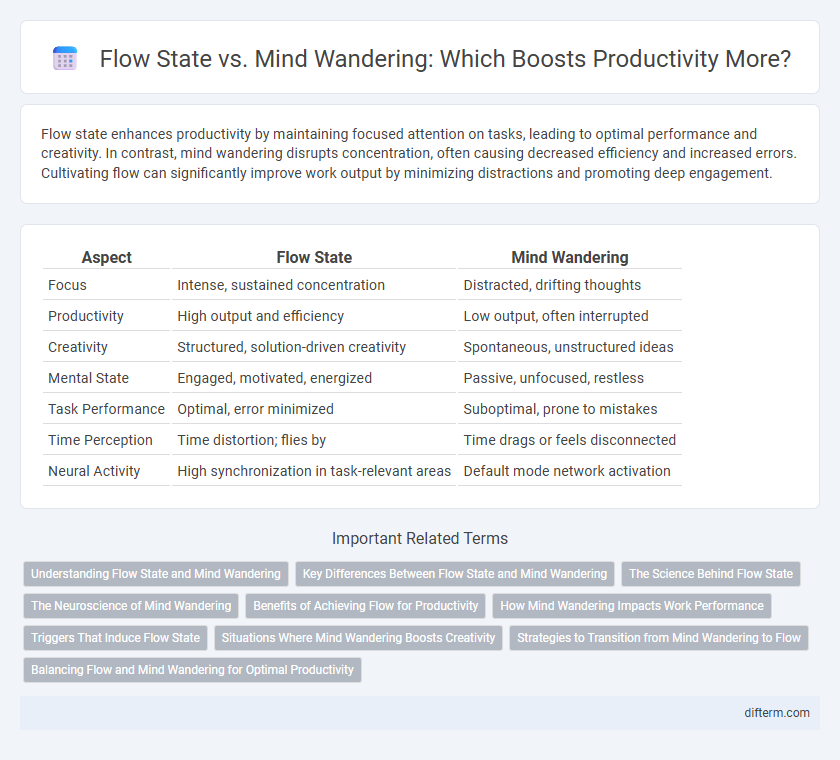Flow state enhances productivity by maintaining focused attention on tasks, leading to optimal performance and creativity. In contrast, mind wandering disrupts concentration, often causing decreased efficiency and increased errors. Cultivating flow can significantly improve work output by minimizing distractions and promoting deep engagement.
Table of Comparison
| Aspect | Flow State | Mind Wandering |
|---|---|---|
| Focus | Intense, sustained concentration | Distracted, drifting thoughts |
| Productivity | High output and efficiency | Low output, often interrupted |
| Creativity | Structured, solution-driven creativity | Spontaneous, unstructured ideas |
| Mental State | Engaged, motivated, energized | Passive, unfocused, restless |
| Task Performance | Optimal, error minimized | Suboptimal, prone to mistakes |
| Time Perception | Time distortion; flies by | Time drags or feels disconnected |
| Neural Activity | High synchronization in task-relevant areas | Default mode network activation |
Understanding Flow State and Mind Wandering
Flow state is a heightened focus condition where individuals experience complete immersion and optimal performance in tasks, characterized by intense concentration and a loss of self-awareness. Mind wandering involves a shift of attention away from a primary task toward unrelated thoughts or feelings, often reducing productivity by disrupting focus. Understanding the neural mechanisms differentiating flow state, associated with increased dopamine and engagement in task-relevant brain areas, from mind wandering, linked to default mode network activation, is crucial for improving cognitive performance and productivity strategies.
Key Differences Between Flow State and Mind Wandering
Flow state is characterized by intense concentration, a sense of control, and seamless task engagement, leading to peak productivity and creativity. Mind wandering involves spontaneous, involuntary shifts in attention away from the task, often causing distraction and reduced performance. The key difference lies in the direction of attention: flow sustains focused immersion, while mind wandering results in fragmented, unfocused thought.
The Science Behind Flow State
The science behind flow state reveals a unique neural pattern where intense focus and effortless action coincide, often linked with increased dopamine levels and transient hypofrontality--the temporary downregulation of the prefrontal cortex. This heightened cognitive state contrasts sharply with mind wandering, which engages the brain's default mode network, associated with introspection and self-referential thought, leading to reduced task performance. Understanding these distinct neural mechanisms underscores flow state's role in maximizing productivity and creativity.
The Neuroscience of Mind Wandering
Mind wandering engages the brain's default mode network, a system linked to spontaneous thought and creativity, contrasting with the focused attention network activated during flow states. Neuroscientific studies reveal that during mind wandering, the prefrontal cortex shows decreased executive control, leading to reduced productivity but enhanced divergent thinking. Understanding the neural mechanisms behind these states can help optimize cognitive performance by balancing focus and mental relaxation.
Benefits of Achieving Flow for Productivity
Achieving flow state significantly enhances productivity by fostering deep concentration and seamless task engagement, leading to higher-quality output and faster completion times. Unlike mind wandering, which often triggers distractions and decreases efficiency, flow maintains cognitive coherence and optimal mental energy. Studies show that individuals in flow experience increased motivation and creativity, directly contributing to sustained performance and goal achievement.
How Mind Wandering Impacts Work Performance
Mind wandering disrupts productivity by diverting attention from tasks, leading to increased errors and slower work completion. Studies show that frequent mind wandering correlates with decreased cognitive control and impaired memory retention, undermining overall work performance. Cultivating strategies to minimize distractions and enhance focus can help maintain flow state, resulting in improved efficiency and output quality.
Triggers That Induce Flow State
Flow state is predominantly triggered by activities that balance challenge with skill level, creating optimal engagement and intrinsic motivation. Clear goals, immediate feedback, and minimized distractions enhance concentration, facilitating deep immersion in tasks that align with personal interests or expertise. This contrasts with mind wandering, which often arises from low-stimulation or monotonous environments lacking structured goals and feedback mechanisms.
Situations Where Mind Wandering Boosts Creativity
Mind wandering can enhance creativity during tasks that require problem-solving or brainstorming by allowing the brain to form novel associations and ideas unconsciously. In moments of relaxed attention, such as during walks or routine activities, the default mode network activates, fostering divergent thinking essential for innovation. Studies show that individuals who experience controlled mind wandering outperform others in generating original solutions compared to those in a strict flow state focused solely on a task.
Strategies to Transition from Mind Wandering to Flow
Transitioning from mind wandering to flow involves targeted techniques such as setting clear goals, minimizing distractions, and practicing mindfulness to anchor attention on the present task. Implementing time-blocking methods and engaging in deep work sessions enhances cognitive control, enabling a seamless shift into flow states. Consistent use of these strategies boosts productivity by aligning mental processes with optimal task engagement.
Balancing Flow and Mind Wandering for Optimal Productivity
Balancing flow state and mind wandering is essential for optimal productivity, as flow enables deep focus and high efficiency, while mind wandering fosters creativity and problem-solving by allowing the brain to make novel connections. Research from cognitive psychology suggests alternating between focused work sessions and brief periods of intentional mind wandering can enhance memory consolidation and innovative thinking. Integrating techniques like the Pomodoro method with mindful daydreaming breaks helps maintain sustained performance and prevents burnout.
Flow state vs Mind wandering Infographic

 difterm.com
difterm.com